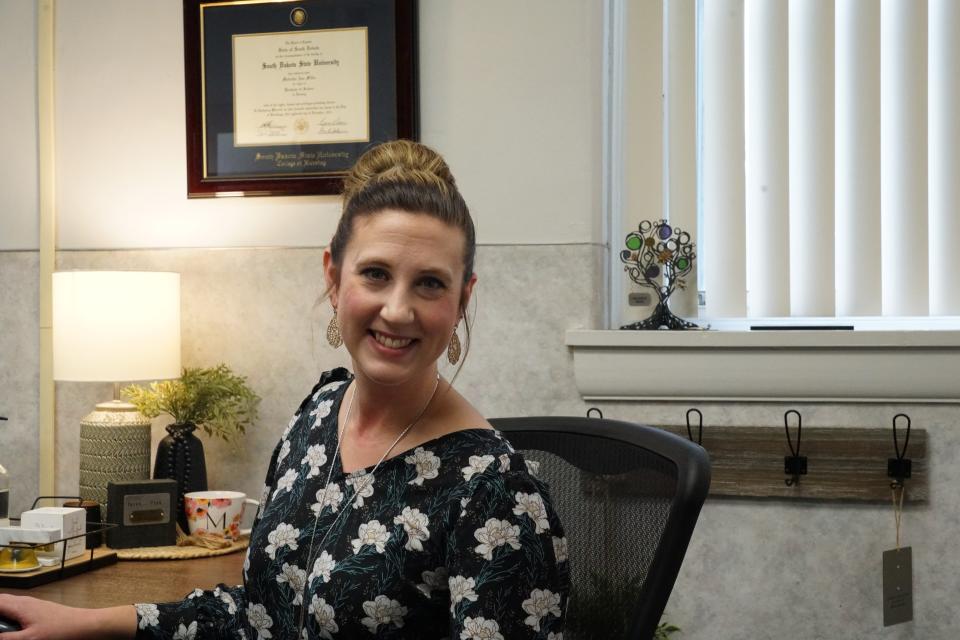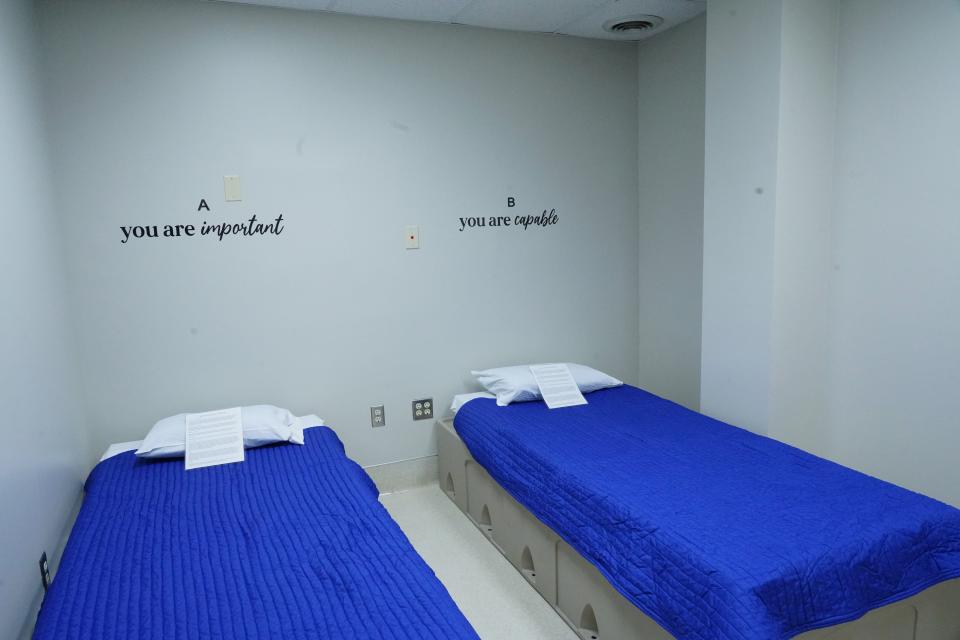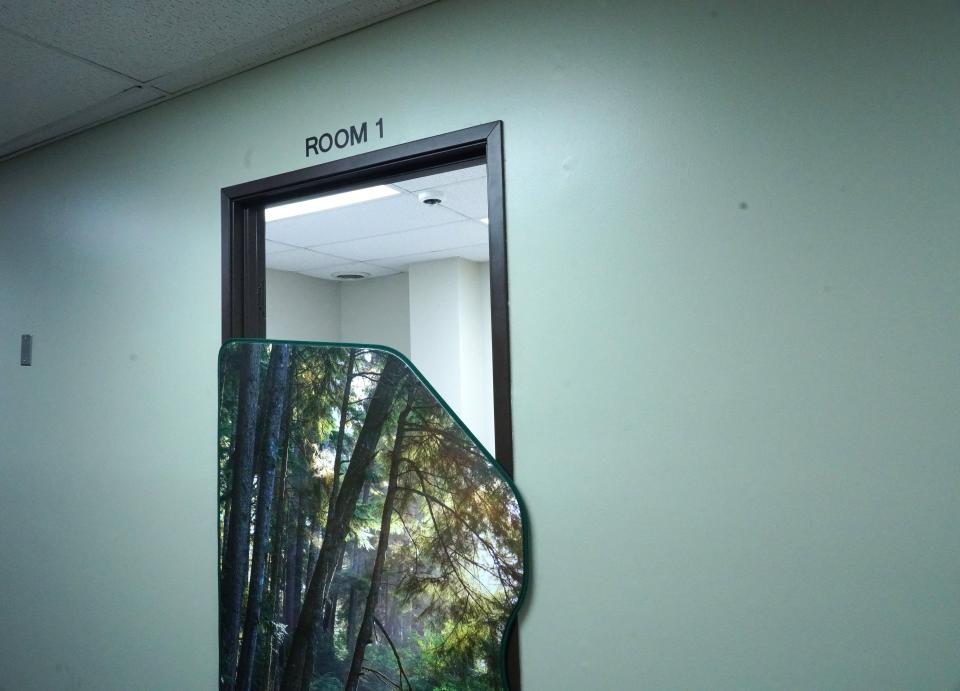CORE Center in Yankton offers short-term mental health stabilization for rural South Dakotans
Madeline Miller has been busy.
In the first 13 days the CORE (Crisis, Outreach, Response, Engagement) Center opened at the beginning of September in Yankton, at least 18 patients seeking short-term crisis help have come to the location.
“We average a little between one to two face-to-face contacts a day, so that was right about where we thought we would be,” said Miller, the Crisis Care program director.
The five new beds at Lewis and Clark Behavioral Health Services, housed in the Benedictine Center on the Avera Sacred Heart Hospital Campus, is part of the first step in providing regional mental health support across South Dakota. The beds are meant to help adults and children receive short-term treatment they may need while experiencing a mental health crisis.

It’s been a process three years in the making at the state level. Legislators in 2020 created law to establish the facilities across South Dakota and the Legislature has continued to place millions of dollars into the facilities, from taking on the cost of the beds so all South Dakotans can have access regardless of ability to pay, to funding the establishments of the facilities and employee raises.
So far two other regional facilities exist like Lewis and Clark in Yankton: Pivot Point in Rapid City and the Human Service Agency in Watertown. Another facility at Avera St. Luke’s in Aberdeen is expected to open in fall 2024.
By 2025, Lewis and Clark will move into a new 60,000 square foot building which will feature 14 short-term crisis stabilization beds and house all of Lewis and Clark’s programs, such as outpatient and addiction services.
More: South Dakota's mental health access struggles have been ongoing for years
How do the beds work?
At Lewis and Clark, the five beds are housed in a small wing at the hospital. There’s a single bed in one room meant for kids and teens, which has a cheery welcome sign on a white board.
The four other beds are split into two rooms with a saloon-style door. Patients may have a roommate of the same gender if other beds are full.

The beds are meant for anyone on a mental health hold, either voluntary or involuntary, or those who are waiting to be seen by a qualified mental health professional, Miller explained. And the beds are meant to keep someone there for between 24 to 72 hours. If needed, someone can stay up to five days.
“Crisis stabilization is different than an inpatient hospital unit in terms that we don’t offer treatment programming,” she said. “We really focus on safety: doing education, discharge planning, safety planning for folks who are returning to home and setting up resources for continued care.”
More: How mental health issues remain unsolved in South Dakota's juvenile detention system
As Lewis and Clark continues to train staff in the coming months, Miller said, they’ll be able to offer detox care for individuals under the influence of drugs and alcohol.
The crisis care beds are an expansion of mental health services already in place, said Terrance Dosch, the South Dakota Council of Community Behavioral Health executive director.

“We always have staffed on a 24/7 basis to respond to mental health emergencies in the communities that we serve," he said. "But we’ve had to do that in kind of a limited basis without facility to actually quickly put people into a safe environment to stabilize their crisis."
Dosch leads the lobbying effort for continued support of the regional crisis centers in Pierre during the legislative session.
More: Why access to South Dakota mental health specialists hasn't improved much in a decade
Expanded support for seven rural South Dakota counties
Lewis and Clark serves seven counties in southern South Dakota, and provides a regional crisis hotline, which works in tandem with the national 988 Mental Health Lifeline, case managers who travel hundreds of thousands of miles a year to do in-person outreach and law enforcement and telehealth services.
“We do a lot of support in our brick and mortar buildings, but we also do a ton out in the communities, in people’s homes, in schools and long-term care center,” she said.
If someone in rural Charles Mix county calls 988 or the Lewis and Clark Crisis line and they are able to be stabilized over the phone, a crisis outreach coordinator is able to do an in-person next-day follow-up to get that person the help they may need, such as finding behavioral health counseling or setting up a safety plan.
More: 988 mental health number a success in South Dakota during first year
Crisis outreach coordinators also work with law enforcement agencies in the area to help people experiencing crisis in jail get connected to services they may need once they’re released, Miller explained.
It can be difficult for mobile crisis teams, similar to what Southeastern Behavioral Health provides in Sioux Falls, to operate in rural areas. The crisis outreach team is one of the ways to meet the need but in a different model, Miller said.
Additionally, for those in the Yankton area Miller said the CORE Center provides similar services to their out-patient clinic, such as having a crisis counselor at the location during the week in the mornings.
More: Lewis & Clark Behavioral Health Services using creative approach for rural crisis response
Why this matters
Miller says everyone deserves to have access to behavioral health and addiction services. And for these services to be provided at no cost to the patient, it may make it a bit easier for them to find the help they need.
“We see all the time that there are individuals that are struggling in these areas and to just really be able to tell them, ‘You’re not alone. We can help you and you don’t have to pay anything for it,’ is huge,” she said.
Dosch added the regional crisis care model is still new and those involved in behavioral health are still learning about how the model can best work.
“This is a monumental step for offering people the types of services that they need in order to stay safe and be well,” he said. “It’s been a journey and now it’s happening.”
This article originally appeared on Sioux Falls Argus Leader: Lewis and Clark CORE Center offers short-term mental health stablization

